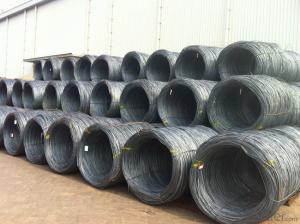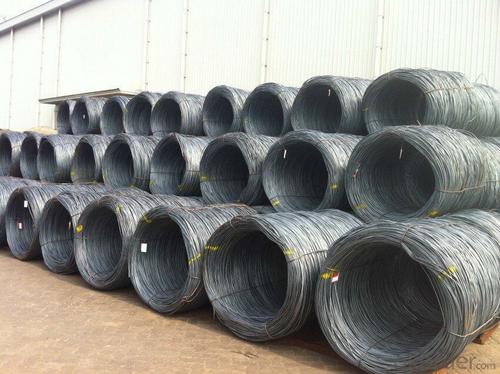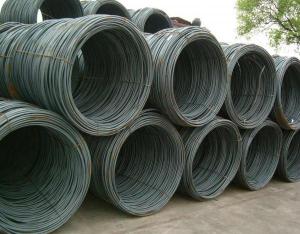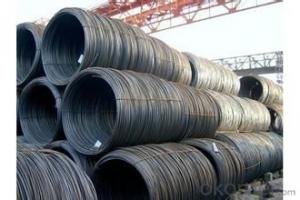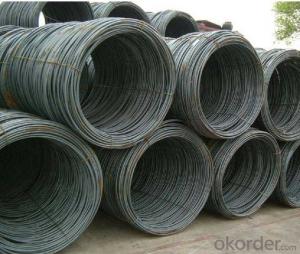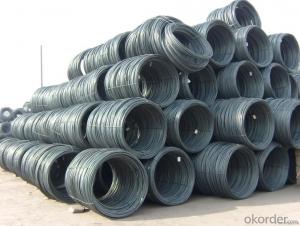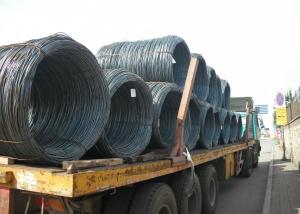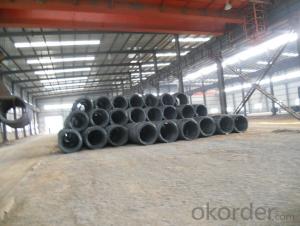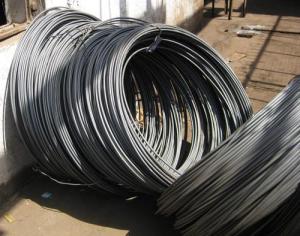Supply Low Carbon Steel Wire Rod for Contruction
- Loading Port:
- Tianjin
- Payment Terms:
- TT OR LC
- Min Order Qty:
- 25 m.t.
- Supply Capability:
- 5000 m.t./month
OKorder Service Pledge
OKorder Financial Service
You Might Also Like
Specification
Specifications of Steel Wire Rod in Coil:
Steel Grade: Q195/235, SAE1006-1018B Standard: ASTM, GB
Diameter: 5.5mm, 6.5mm, 7mm,8mm,9mm,10mm,12mm,14mm
Type: Drawn Wire Alloy or Not: Alloy Brand Name: HSKY
Technique: Hot Rolled Place of Origin: China Mainland
Chemical Composition:(Please kindly find our chemistry of our material based on SAE1006B and SAE1008B as below for your information)
High carbon/Low carbon/common carbon Steel wire rod | With boron for rebate tax |
Grade | SAE1006B SAE1008B SAE1018B |
Package | In coil ,in bundle, |
Coil weight | about 2000kg-3000kgs |
Size: | 5.5mm 6.5mm 8mm 10mm 12mm 14mm 16mm |
Types | High Carbon ,Low carbon ,Common carbon |
Exported Country | South Korea,Vietnam,Indonesia,Myanmar,Philippines and Afrca,Ect |
Delivery term: | within 30 days after receive the LC |
Payment Term: | LC at sight ,LC 30-120 days after B/L date, TT payment |
The Standard of Physical Properties:
Grade | Chemical Composition(%) | |||||
C | Mn | Si | S | P | Cr | |
SAE1006 | 0.03~O.07 | ≤0.32 | ≤0.30 | ≤0.045 | ≤0.040 | >0.30 |
Mechanical properties | ||||||
Yield strength(N/mm2) | Tensile strength(N/mm2) | Elongation(%) | ||||
250-280 | 350-380 | ≥32 | ||||
Grade | Chemical Composition(%) | |||||
C | Mn | Si | S | P | Cr | |
SAE1008 | 0.10max | 0.3~O.50 | 0.15max | 0.050max | 0.040 max | 0.30 min |
Mechanical properties | ||||||
Yield strength(N/mm2) | Tensile strength(N/mm2) | Elongation(%) | ||||
≥195 | 315-430 | ≥30 | ||||
Usage and Applications of Steel Wire Rod in Coil:
After hot-rolled the products shaped into coil and delivery as finished product, including round, square, rectangular, hexagonal and so on, Since most of the products are round, it is generally called wire rod. Steel wire rod is widely used in construction and manufacturing. Steel wire rod is mainly used for reinforcement of reinforced concrete and welded structure or reprocessed (roberts, nail etc) materials, especially used to produce wire drawing, welding electrode, nails,spring, electronic, precise machinery parts and so on.
Packaging & Delivery of Steel Wire Rod in Coil:
Packaging Detail: products are packed in coil and then shipped by container or bulk vessel
Each coil weight: 2-3MT
Delivery Detail: within 45 days after received deposit or LC.
Label: to be specified by customer, generally, each bundle has 1-2 labels
Trade terms: CFR, CIF
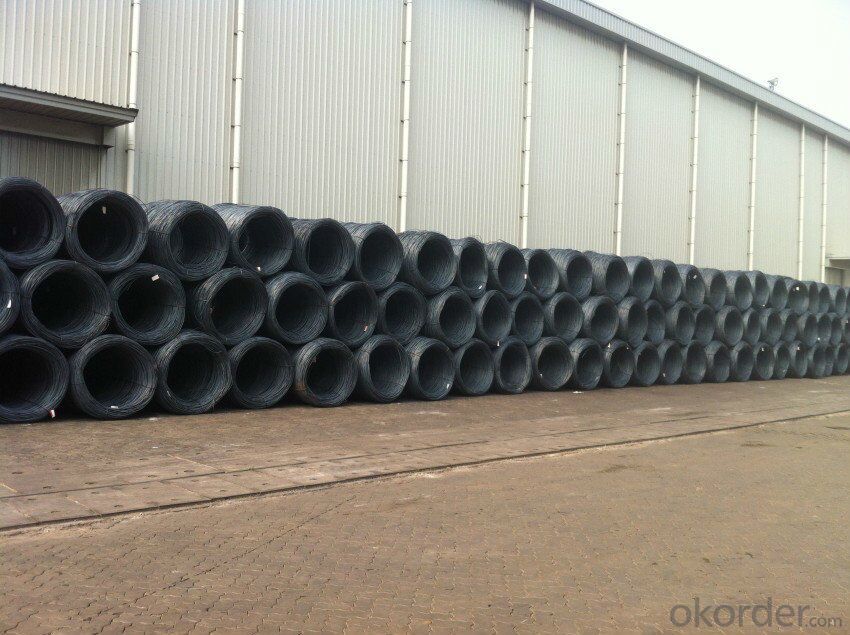
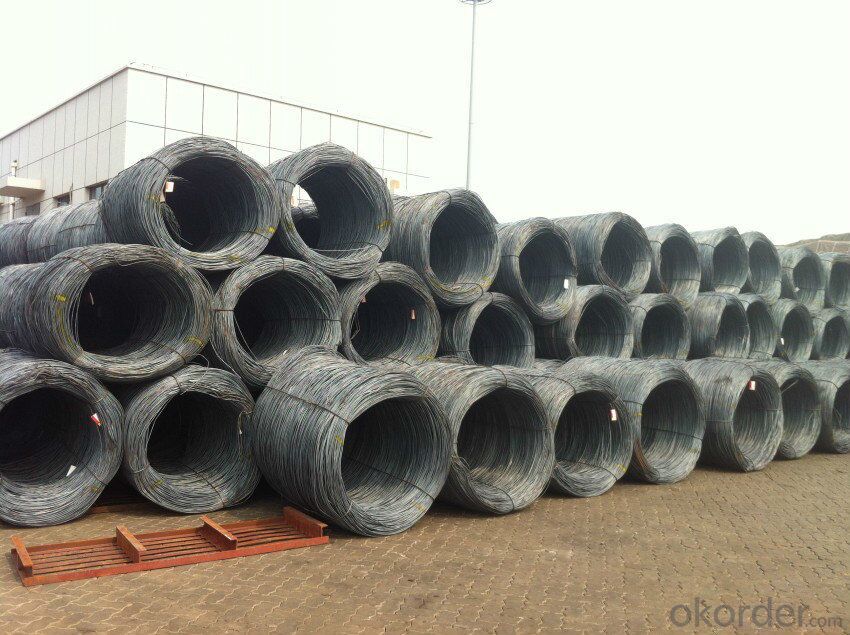
- Q: What are the different types of steel wire rod defects that can occur during wire drawing?
- There are several types of steel wire rod defects that can occur during the wire drawing process. These defects can impact the quality and performance of the final wire product. Some common defects include: 1. Surface cracks: These are visible cracks on the surface of the wire rod and can occur due to improper cooling or excessive rolling pressure. Surface cracks can weaken the wire and lead to premature failure. 2. Internal cracks: Unlike surface cracks, internal cracks are not visible to the naked eye. They can occur due to improper heating or cooling during the manufacturing process. Internal cracks can compromise the wire's strength and ductility. 3. Scale: Scale refers to the oxide layer that forms on the surface of the wire rod during the manufacturing process. Excessive scale can cause surface defects and reduce the wire's corrosion resistance. 4. Decarburization: This defect occurs when the carbon content of the wire rod is reduced due to excessive heating or prolonged exposure to high temperatures. Decarburization can weaken the wire and affect its mechanical properties. 5. Segregation: Segregation refers to the non-uniform distribution of alloying elements within the wire rod. It can lead to inconsistent mechanical properties and affect the wire's performance. 6. Surface defects: These defects include scratches, pits, or indentations on the wire rod's surface. They can occur due to improper handling or inadequate maintenance of the production equipment. 7. Overlaps: Overlaps are defects that occur when the wire rod is not properly aligned during the wire drawing process. This can result in uneven thickness or irregular cross-sections in the final wire product. 8. Surface contamination: Contaminants such as dirt, oil, or rust can adhere to the surface of the wire rod during production or storage. Surface contamination can lead to reduced adhesion, poor surface finish, or corrosion issues. It is important to identify and address these defects during the wire drawing process to ensure the production of high-quality wire products that meet the desired specifications and performance requirements.
- Q: What are the main factors influencing the choice of steel wire rod order warranty claims process?
- The choice of the warranty claims process for steel wire rod orders can vary depending on several factors. Firstly, the quality of the wire rod plays a significant role in determining how often and how straightforward the warranty claims process will be. If the wire rod meets the required standards and is of high quality, there may be fewer claims and a simpler process. Conversely, if the wire rod has inherent flaws or defects, there is a higher likelihood of warranty claims, resulting in a more complex process. Secondly, the terms and conditions of the warranty provided by the supplier or manufacturer can greatly impact the choice of the warranty claims process. The duration, coverage, and any limitations or exclusions of the warranty can influence decision-making. A comprehensive warranty with a reputable supplier can instill confidence in the buyer, making them more likely to choose that specific claims process. Additionally, the availability and efficiency of customer support and after-sales service are crucial factors in deciding the warranty claims process. Responsive and prompt customer support can expedite the claims process, provide guidance, and address any concerns or queries from the buyer. This level of support significantly influences the choice of the warranty claims process, ensuring a smoother and more satisfactory experience. Furthermore, the reputation and track record of the supplier or manufacturer also impact decision-making. Buyers are more likely to select a warranty claims process from a trustworthy supplier with a history of promptly and fairly honoring warranty obligations. This factor provides peace of mind and increases confidence in choosing a particular claims process. Lastly, the cost-effectiveness and convenience of the warranty claims process can play a role in the decision. If the process is affordable and convenient for the buyer, they may be more inclined to choose that specific claims process. This includes factors such as the ease of filing a claim, the time taken for resolution, and any associated costs or deductibles. Overall, the key factors influencing the choice of warranty claims process for steel wire rod orders are the quality of the product, the terms and conditions of the warranty, the availability of customer support, the reputation of the supplier, and the cost-effectiveness and convenience of the process.
- Q: How is steel wire rod used in the manufacturing of wire rope cables?
- Steel wire rod is used in the manufacturing of wire rope cables as it serves as the raw material for creating the individual wires that form the strands of the cable. The steel wire rod is first drawn through a series of dies to reduce its diameter and increase its tensile strength. These wires are then twisted together to form strands, which are further twisted together to create the final wire rope cable. The high strength and durability of steel wire rod make it ideal for withstanding the heavy loads and stresses that wire rope cables are commonly subjected to.
- Q: What are the common standards for steel wire rod?
- The common standards for steel wire rod vary depending on the industry and the specific application. However, there are several widely recognized standards that are commonly followed in the steel wire rod manufacturing industry. One of the most widely accepted standards is the American Society for Testing and Materials (ASTM) standard. ASTM A510/A510M is the standard specification for general requirements for carbon and alloy steel wire rods and coarse round wire. This standard provides the general requirements for steel wire rods in terms of chemical composition, mechanical properties, dimensions, and tolerances. Another common standard is the International Organization for Standardization (ISO) standard. ISO 16120-2 specifies the general requirements for non-alloy steel wire rod for conversion to wire. This standard outlines the chemical composition, mechanical properties, and dimensions of non-alloy steel wire rods. In addition to these standards, there are also industry-specific standards for steel wire rod. For example, the automotive industry has its own set of standards that are followed by manufacturers to ensure the quality and performance of steel wire rods used in automotive applications. Overall, the common standards for steel wire rod include ASTM A510/A510M, ISO 16120-2, and industry-specific standards. These standards ensure that steel wire rods meet the necessary requirements for their intended applications and promote consistency and quality in the manufacturing process.
- Q: How does the fatigue strength of steel wire rod vary with different wire drawing processes?
- The specific wire drawing process utilized can lead to varying fatigue strengths in steel wire rods. Wire drawing, a metalworking procedure that involves pulling a metal wire through a die to decrease its diameter and increase its length, is the key process. There are multiple wire drawing processes available, including wet drawing, dry drawing, and intermediate drawing, each having distinct characteristics and impacts on the fatigue strength of the steel wire rod. One factor that affects fatigue strength is the lubrication employed during the wire drawing process. Wet drawing entails immersing the wire rod in a lubricant to decrease friction and heat generation. This lubrication aids in minimizing surface defects and improving the fatigue strength of the wire rod. Conversely, dry drawing does not entail any lubrication, which can result in increased friction and heat generation, potentially leading to a decrease in fatigue strength. The reduction ratio, the ratio of the initial wire diameter to the final wire diameter, also plays a vital role. Higher reduction ratios can enhance the fatigue strength of the wire rod as the process aligns the grain structure and improves overall mechanical properties. However, excessively high reduction ratios can introduce internal defects or residual stresses, which can have a negative impact on fatigue strength. The subsequent heat treatment process after wire drawing can significantly influence fatigue strength as well. Heat treatment techniques, such as annealing or quenching, can enhance the microstructure of the wire rod and improve its fatigue strength. Annealing helps alleviate internal stresses and refine the grain structure, while quenching provides increased hardness and strength. These heat treatment processes can compensate for any potential reduction in fatigue strength caused by the wire drawing process. In conclusion, the fatigue strength of steel wire rod can vary depending on the wire drawing process employed. Factors such as lubrication, reduction ratio, and heat treatment techniques all have an impact on fatigue strength. It is crucial to carefully select the appropriate wire drawing process and associated parameters to optimize the fatigue strength of the steel wire rod for specific applications.
- Q: How is steel wire rod used in the manufacturing of wire for surgical sutures?
- Steel wire rod is used in the manufacturing of wire for surgical sutures by being drawn down to the desired diameter and then coated with a biocompatible material such as chromium or silicone. This process ensures that the wire is smooth, sterile, and strong enough to be used in sutures for various medical procedures.
- Q: How is the fatigue resistance of steel wire rod tested?
- The fatigue resistance of steel wire rod is typically tested using a cyclic fatigue test. This involves subjecting the wire rod to repeated loading and unloading cycles until it fails. The number of cycles required to cause failure, as well as any changes in the wire rod's mechanical properties during the test, are measured and analyzed to determine its fatigue resistance.
- Q: What are the common industry advancements for steel wire rod?
- Some common industry advancements for steel wire rod include improved manufacturing processes, such as enhanced rolling techniques and heat treatment methods, leading to higher quality and strength. Other advancements include the development of new alloys and coatings to enhance corrosion resistance and durability. Additionally, advancements in automation and digitalization have improved the efficiency and accuracy of production processes, leading to faster and more cost-effective manufacturing.
- Q: How is steel wire rod used in the production of wire mesh for industrial filtration systems?
- Steel wire rod is used in the production of wire mesh for industrial filtration systems as it serves as the primary material for manufacturing the mesh. The wire rod is first drawn through a series of dies to reduce its diameter and increase its length. This process, known as wire drawing, results in a thin and continuous wire that is then woven or welded to form a mesh structure. The strength and durability of steel wire make it ideal for withstanding the high pressures and harsh operating conditions encountered in industrial filtration systems. Additionally, the uniformity and precision of the wire rod ensure the production of a consistent and reliable wire mesh product.
- Q: How is steel wire rod used in the manufacturing of wire forms for conveyor systems?
- Steel wire rod is an essential component in the manufacturing of wire forms for conveyor systems. It serves as the raw material from which wire forms are created. The wire rod is first processed by undergoing a series of mechanical and thermal treatments, such as hot rolling, cold drawing, and annealing, to enhance its strength, ductility, and flexibility. Once the wire rod has been properly processed, it is then formed into various wire shapes that are specifically designed for conveyor systems. These wire forms can include wire mesh belts, wire spirals, wire ropes, and wire hooks, among others. Each wire form serves a specific purpose in the conveyor system, such as supporting the weight of the conveyed material, guiding the movement of the conveyor belt, or securing and fastening various components of the system. The steel wire rod used in the manufacturing of wire forms for conveyor systems is chosen for its high tensile strength, corrosion resistance, and durability. These properties ensure that the wire forms can withstand the harsh operating conditions of conveyor systems, such as heavy loads, high speeds, and exposure to various environmental factors. Overall, steel wire rod plays a crucial role in the manufacturing of wire forms for conveyor systems by providing the necessary raw material with the required mechanical properties. Its utilization ensures the reliable and efficient operation of conveyor systems in various industries, including mining, manufacturing, transportation, and logistics.
Send your message to us
Supply Low Carbon Steel Wire Rod for Contruction
- Loading Port:
- Tianjin
- Payment Terms:
- TT OR LC
- Min Order Qty:
- 25 m.t.
- Supply Capability:
- 5000 m.t./month
OKorder Service Pledge
OKorder Financial Service
Similar products
Hot products
Hot Searches
Related keywords
